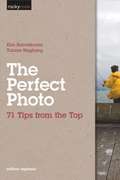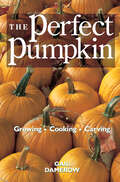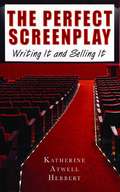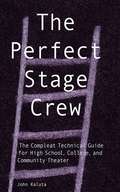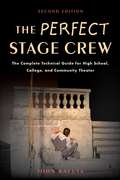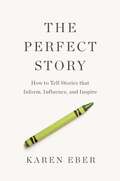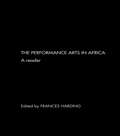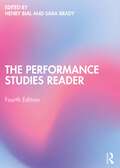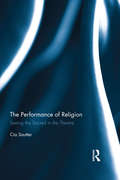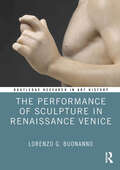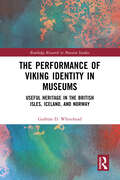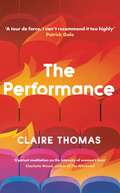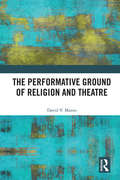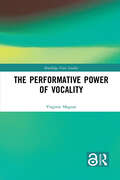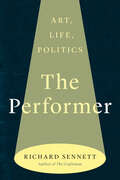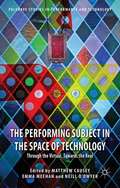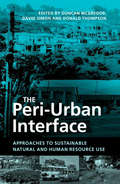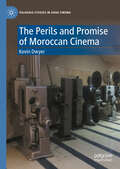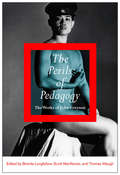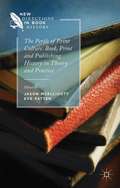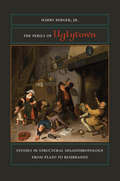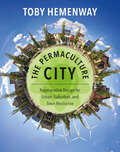- Table View
- List View
The Perfect Photo
by Elin Rantakrans Tobias Hagberg"Perfect" is a purely subjective term when it comes to art. A journey toward the perfect photo is a journey without a defined destination. There are photographs that are technically perfect and others that stand out because of their message or composition. Although the perfect photo remains a matter of taste, it is still something every photographer strives for. With this volume, Elin Rantakrans and Tobias Hagberg provide the beginning to intermediate photographer a wide range of practical tips that cover capture, composition, and editing--all with the aim of helping you achieve better photos. Each concept is illustrated with beautiful, inspiring images. Our promise: Use 7 of these 70 tips and you will be a 10% better photographer. Try it!
The Perfect Pumpkin: Growing/Cooking/Carving
by Gail DamerowThe big orange pumpkin is no longer just for Halloween! Gail Damerow shows you how to cultivate more than 95 varieties of pumpkin, and provides recipes for pumpkin pies, muffins, and even pumpkin beer. You’ll also learn how to use pumpkins in a variety of craft projects, from carving unique jack-o’-lanterns to creating pumpkin-scented creams and soaps. With tips on growing giant pumpkins, preserving your harvest through the winter, and much more, The Perfect Pumpkin will delight pumpkin lovers of all sensibilities.
The Perfect Screenplay: Writing It and Selling It
by Katherine HerbertThey say in L.A. everybody is writing a screenplay. With The Perfect Screenplay, everybody everywhere will be writing well-presented, saleable screenplays. Packed with tips from an insider on how Hollywood operates, testing script ideas, building structure, and marketing the final screenplay, this book is the key to getting work read and sold. A resource list gives Web sites, agents, and more. Writers will be thanking the little people-and The Perfect Screenplay. Written by a top Hollywood script analyst From computer screen to silver screen in clear, easy-to-follow steps
The Perfect Stage Crew: The Compleat Technical Guide for High School, College, and Community Theater
by John KalutaHere is an indispensable, nuts-and-bolts guide to putting on a stunning, low-budget show in less than 40 days! The Perfect Stage Crew explains the pitfalls to avoid and provides solutions to the most common as well as most complex stage performance problems. Readers without Broadway-size budgets and resources will learn the low-cost, low-tech approaches to painting scenery, building sets, hanging lights, setting cues, and operating sound. They'll also find crucial guidance for generating publicity, preparing tickets, technical rehearsals, and more.
The Perfect Stage Crew: The Complete Technical Guide for High School, College, and Community Theater
by John KalutaHere is a must-have book for anyone producing a stage show without a Broadway-sized budget. Written by a technical theater veteran, The Perfect Stage Crew explains the pitfalls to avoid and provides solutions to the most common-and the most complex-stage performance problems, even for theaters with a lack of resources. An invaluable guide for middle and high school theaters, college theaters, and community theaters, The Perfect Stage Crew teaches readers how to:Stock, organize, and store the essential backstage suppliesConceptualize, design, and build setsManage a stage crew effectivelyPaint scenery and backdropsTest, design, and hang lightingOperate and repair sound equipmentSet cuesPromote your showThis expanded second edition covers up-to-date technology, including for use with recording, sound, and lighting. Chapters also cover such crucial topics as running technical rehearsals, gathering props, and creating and selling tickets. Theater groups that need to learn the nuts and bolts of putting a show together will discover how to turn backstage workers into The Perfect Stage Crew.Allworth Press, an imprint of Skyhorse Publishing, publishes a broad range of books on the visual and performing arts, with emphasis on the business of art. Our titles cover subjects such as graphic design, theater, branding, fine art, photography, interior design, writing, acting, film, how to start careers, business and legal forms, business practices, and more. While we don't aspire to publish a New York Times bestseller or a national bestseller, we are deeply committed to quality books that help creative professionals succeed and thrive. We often publish in areas overlooked by other publishers and welcome the author whose expertise can help our audience of readers.
The Perfect Story: How to Tell Stories that Inform, Influence, and Inspire
by Karen Eber"Come for the engrossing content, and stay for the lessons that might just change how you talk, write, and lead.&” —Adam GrantLearn how to take any story and make it perfect—from storytelling expert Karen Eber, whose popular TED Talk on the subject continues to be a source of inspiration for millions.What makes a story perfect? How do you tell the perfect story for any occasion?We live in a story world. Stories are a memorable and engaging way to differentiate yourself, build connection and trust, create new thinking, bring meaning to data, and even influence decision-making. But how do you turn a good story into a great story that informs, influences, and inspires?In The Perfect Story, Karen Eber—leadership consultant, professional keynote storyteller, and TED speaker—shares the science of storytelling to teach you to:Leverage the Five Factory Settings of the Brain to hack the art of storytellingBuild a toolkit of endless story ideasDefine the audience for your storyApply a memorable story structureEngage senses and emotionsTell stories with dataAvoid common storytelling mistakesUse your body to tell dynamic storiesEnsure your story doesn't manipulateNavigate and embrace the vulnerability of storytellingWithout relying on complicated models or one-size-fits-all prescriptions, this book makes storytelling accessible with practical and impactful steps for anyone to tell the perfect story for any occasion.Through interview vignettes, The Perfect Story also shares approaches from different storytellers, including the Sundance Institute cofounder, an executive producer of The Moth, the former creative director at Pixar, the TED Radio Hour podcast host, and many more.Whether you are leading a team, giving a presentation, hosting a podcast, selling a product or service, interviewing for a job, or giving a toast at a wedding, The Perfect Story will help you take your stories and make them perfect.
The Performance Arts in Africa: A Reader
by Frances HardingThe Performance Arts in Africa is the first anthology of key writings on African performance from many parts of the continent. As well as play texts, off the cuff comedy routines and masquerades, this exciting collection encompasses community-based drama, tourist presentations, television soap operas, puppet theatre, dance, song, and ceremonial ritualised performances. Themes discussed are: * theory * performers and performing * voice, language and words * spectators, space and time. The book also includes an introduction which examines some of the crucial debates, past and present, surrounding African performance. The Performance Arts of Africa is an essential introduction for those new to the field and is an invaluable reference source for those already familiar with African performance.
The Performance Studies Reader
by Sara Brady Henry BialSince its first publication in 2004, The Performance Studies Reader has become the leading anthology of key writings on performance studies. Now in its fourth edition, it continues to offer an unparalleled selection of work by the foremost scholars in this continually evolving field, offering a stimulating introduction to the crucial debates of Performance Studies. These critical and theoretical contributions are joined in this edition by 26 new chapters, bringing the collection up to date with current discourse and ideas, and significantly expanding the range of subjects and authors represented. Each essay includes contextual headnotes from the editors, to introduce students to the writer and their impact on the field. Newly added to this edition are contributions from Swati Arora; Sara Ahmed; Sarah Bay-Cheng; Claire Bishop; Felipe Cervera, Theron Schmidt, and Hannah Schwadron; Anita E. Cherian and Gargi Bharadwaj; Thomas F. DeFrantz/SLIPPAGE; Soyica Diggs Colbert; Tracy C. Davis; Saidiya V. Hartman; Travis Jackson; Branislav Jakovljević; Ailton Krenak; André Lepecki; Fred Moten; José Esteban Muñoz; Tavia Nyong'o; Tamara Searle; Stephanie Nohelani Teves; and McKenzie Wark.This new edition of The Performance Studies Reader provides an overview of the full range of performance theory for undergraduates at all levels, and beginning graduate students in Performance Studies, theatre, performing arts, and cultural studies.
The Performance of Nationalism
by Jisha MenonImagine the patriotic camaraderie of national day parades. How crucial is performance for the sustenance of the nation? The Performance of Nationalism considers the formation of the Indian and Pakistani nation, in the wake of the most violent chapter of its history: the partition of the subcontinent. In the process, Jisha Menon offers a fresh analysis of nationalism from the perspective of performance. Menon recuperates the manifold valences of "mimesis" as aesthetic representation, as the constitution of a community of witnesses, and as the mimetic relationality that underlies the encounter between India and Pakistan. The particular performances considered here range from Wagah border ceremonies, to the partition theatre of Asghar Wajahat, Kirti Jain, M. K. Raina, and the cinema of Ritwik Ghatak and M. S. Sathyu. By pointing to the tropes of twins, doubles, and doppelgangers that suffuse these performances, this study troubles the idea of two insular, autonomous nation-states of India and Pakistan. In the process, Menon recovers mimetic modes of thinking that unsettle the reified categories of identity politics.
The Performance of Religion: Seeing the sacred in the theatre
by Cia SautterThe performing arts are uniquely capable of translating a vision of an ideal or sacred reality into lived practice, allowing an audience to confront deeply held values and beliefs as they observe a performance. However, there is often a reluctance to approach distinctly religious topics from a performance studies perspective. This book addresses this issue by exploring how religious values are acted out and reflected on in classic Western theatre, with a particular emphasis on the plays put on during the Globe Theatre‘s yearlong season of 'Shakespeare and the Bible'. Looking at plays such as Much Ado About Nothing, Dr. Faustus and Macbeth, each chapter includes ethnographic overviews of the performance of these plays as well as historical and theological perspectives on the issues they address. The author also utilizes scholarship from other academics, such as Paul Tillich and Martin Buber, in examining the relationship between art and culture. This helps readers of this book to look at religion in culture, and raise questions and explore ideas about how people appraise their religious values through an encounter with a performance. The Performance of Religion: Seeing the sacred in the theatre treads new ground in bringing performance and religious studies scholarship into direct conversation with one another. As such, it is essential reading for any academic with an interest in theology, religion and ethics and their expression in culture through the performing arts.
The Performance of Sculpture in Renaissance Venice (Routledge Research in Art History)
by Lorenzo G. BuonannoThis study reveals the broad material, devotional, and cultural implications of sculpture in Renaissance Venice. Examining a wide range of sources—the era’s art-theoretical and devotional literature, guidebooks and travel diaries, and artworks in various media—Lorenzo Buonanno recovers the sculptural values permeating a city most famous for its painting. The book traces the interconnected phenomena of audience response, display and thematization of sculptural bravura, and artistic self-fashioning. It will be of interest to scholars working in art history, Renaissance history, early modern art and architecture, material culture, and Italian studies.
The Performance of Viking Identity in Museums: Useful Heritage in the British Isles, Iceland, and Norway (Routledge Research in Museum Studies)
by Guðrún D. WhiteheadThe Performance of Viking Identity in Museums explores the representations and uses of Vikings in museums across Iceland, British Isles and Norway.Drawing on theories from history, philosophy, museology, and sociology, the book analyses how the Viking myth is used by visitors to make sense of present-day society, culture, and politics and the role of museums in this meaning-making process. Demonstrating that the Viking myth is present in collective memory and plays an important role in the construction and modification of collective, national, and personal identities, the book analyses this process through the framework of museums and their visitors. Identifying museums as places where heritage, identity and social norms are affirmed and reflected upon, Whitehead demonstrates that all countries use their Viking heritage to define their identity on a local and international level - through tourist attractions such as museums and other Viking-related monuments and merchandise.Providing readers with an insight into Vikings and their social relevance today, The Performance of Viking Identity in Museums will be of great interest to academics and researchers across the social and human sciences. It should also be essential reading for museum professionals working in museums around the world.
The Performance: A Novel
by Claire Thomas'Quietly transformational'The Times 'A tour de force... I can't recommend this too highly'Patrick Gale'Innovative... an original, at-a-sitting read'Daily Mail'A potent meditation on the intensity of women's lives'Charlotte Wood, author of The Weekend'A miracle... Engaging and evocative'Washington Post'I loved and admired The Performance... Unmissable'Emma Stonex, author of The Lamplighters'Lively and intimate... The way Thomas plays with the reader is a sort of genius'Guardian'Thomas writes these women with such wisdom and compassion, that by the end we are all transformed'Claire Fuller, author of Unsettled Ground The false cold of the theatre makes it hard to imagine the heavy wind outside in the real world, the ash air pressing onto the city from the nearby hills where bushfires are taking hold.The house lights lower.The auditorium feels hopeful in the darkness.As bushfires rage outside the city, three women watch a performance of a Beckett play.Margot is a successful professor, preoccupied by her fraught relationship with her ailing husband. Ivy is a philanthropist with a troubled past, distracted by the snoring man beside her. Summer is a young theatre usher, anxious about the safety of her girlfriend in the fire zone.As the performance unfolds, so does each woman's story. By the time the curtain falls, they will all have a new understanding of the world beyond the stage.
The Performative Ground of Religion and Theatre
by David V. MasonReligious practitioners and theatregoers have much in common. So much, in fact, that we can say that religion is often a theatrical phenomenon, and that theatre can be a religious experience. By examining the phenomenology of religion, we can in turn develop a better understanding of the phenomenology of theatre. That is to say, religion can show us the ways in which theatre is not fake. This study explores the overlap of religion and theatre, especially in the crucial area of experience and personal identity. Reconsidering ideas from ancient Greece, premodern India, modern Europe, and the recent century, it argues that religious adherents and theatre audiences are largely, themselves, the mechanisms of their experiences. By examining the development of the philosophy of theatre alongside theories of religious action, this book shows how we need to adjust our views of both. Featuring attention to influential notions from Plato and Aristotle, from the Natyashastra, from Schleiermacher to Sartre, Bourdieu, and Butler, and considering contemporary theories of performance and ritual, this is vital reading for any scholar in religious studies, theatre and performance studies, theology, or philosophy.
The Performative Power of Vocality (Routledge Voice Studies)
by Virginie MagnatThe Performative Power of Vocality offers a fresh perspective on voice as a subject of critical inquiry by employing an interdisciplinary and cross-cultural approach. Conventional treatment of voice in theatre and performance studies too often regards it as a subcategory of actor training, associated with the established methods that have shaped voice pedagogy within Western theatre schools, conservatories, and universities. This monograph significantly deviates from these dominant models through its investigation of the non-discursive, material, and affective efficacy of vocality, with a focus on orally transmitted vocal traditions. Drawing from her performance training, research collaborations, and commitment to cultural diversity, Magnat proposes a dialogical approach to vocality. Inclusive of established, current, and emerging research perspectives, this approach sheds light on the role of vocality as a vital source of embodied knowledge, creativity, and well-being grounded in process, practice, and place, as well as a form of social and political agency. An excellent resource for qualitative researchers, artist-scholars, and activists committed to decolonization, cultural revitalization, and social justice, this book opens up new avenues of understanding across Indigenous and Western philosophy, performance studies, musicology, ethnomusicology, sound and voice studies, anthropology, sociology, phenomenology, cognitive science, physics, ecology, and biomedicine.
The Performer: Art, Life, Politics
by Richard SennettAn acclaimed sociologist&’s exploration of the connections among performances in life, art, and politics In The Performer, Richard Sennett explores the relations between performing in art (particularly music), politics, and everyday experience. It focuses on the bodily and physical dimensions of performing, rather than on words. Sennett is particularly attuned to the ways in which the rituals of ordinary life are performances. The book draws on history and sociology, and more personally on the author&’s early career as a professional cellist, as well as on his later work as a city planner and social thinker. It traces the evolution of performing spaces in the city; the emergence of actors, musicians, and dancers as independent artists; the inequality between performer and spectator; the uneasy relations between artistic creation and social and religious ritual; the uses and abuses of acting by politicians. The Janus-faced art of performing is both destructive and civilizing.
The Performing Artist's Handbook
by Janice PapolosThe right ways to handle all of the nonmusical essentials of your career, the practical know-how you need to progress in your professional music career.
The Performing Subject in the Space of Technology
by Matthew CauseyNow that the shock of the virtual has subsided toward a 'new-normal' of computational interference in all areas of life, it is an advantageous moment to reflect on the passage through the virtual and back to the real. Digital culture has developed into a bio-virtual environment in which the categories of the biological and the virtual no longer stand as separate. The contributors to this volume respond to the questions raised by the 'after-event' of the digital through practice-led researchanalyses of performance processes, philosophical readings of the work of art and technology, and performance studies investigations of the subject in the spaces of technology. The volume examines a wide range of activities, from bio-art to internet child pornography, gaming and social networking technologies to the use of motion-tracking in developing choreography and documentation. The authors draw from diverse perspectives in dance, theatre, performance, film and music studies, digital arts and culture.
The Peri-Urban Interface: Approaches to Sustainable Natural and Human Resource Use
by David Simon Duncan McGregorPeri-urban interfaces - the zones where urban and rural areas meet - suffer from the greatest problems to humans caused by rapid urbanization, including intense pressures on resources, slum formation, lack of adequate services such as water and sanitation, poor planning and degradation of farmland. These areas, home to hundreds of millions of people, face unique problems and need distinctive and innovative approaches and solutions. This book, authored by top researchers and practitioners, covers the full breadth and depth of the impacts of rapid urbanization on livelihoods, poverty and resources in the peri-urban zones in diverse African, Asian, Latin American and Caribbean contexts. Topics include peri-urban resource sustainability, ecosystems and societies and environmental changes in peri-urban zones. Rich case studies cover production systems and livelihoods including the impacts of irrigated vegetable production, horticulture, dairy enterprises, waste-fed fisheries and pastoral livelihoods. Also addressed are planning and development issues in the peri-urban interface including the difficulty in achieving sustainability, conflict and cooperation over resources, and a fresh look at the relationship between people and their environment. The final part of the book presents policies and strategies for promoting and measuring sustainability in peri-urban zones including community-based waste management, the co-management of watersheds and empowerment of the poor. This book is the most comprehensive examination of the challenges and solutions facing the people and environments of peri-urban zones and is essential reading for all practitioners, students and academics in geography and development.
The Perils and Promise of Moroccan Cinema (Palgrave Studies in Arab Cinema)
by Kevin DwyerBased on extended field research and meetings with members of Morocco’s film world, this book traces the development of Moroccan cinema over the past three decades. Drawing from his extensive work on Moroccan cinema, Kevin Dwyer discusses important aspects of Moroccan film culture such as freedom of expression, the role of women, cultural diversity, the promotion of culture, the role of humor, the shifting emphasis on the urban, autobiographical aspects of films, and the development of documentary films. Dwyer closely analyzes a significant number of Moroccan films, providing crucial details about filmmakers; historical context; and comparisons with the cinemas of Tunisia, Algeria, and Egypt.
The Perils of Pedagogy
by Scott Mackenzie Thomas Waugh Brenda LongfellowWhether addressing HIV/AIDS, the policing of bathroom sex, censorship, or anti-globalization movements, John Greyson has imbued his work with cutting humour, eroticism, and postmodern aesthetics. Mashing up high art, opera, community activism, and pop culture, Greyson challenges his audience to consider new ways that images can intervene in both political and public spheres. Emerging on the Toronto scene in the late 1970s, Greyson has produced an eclectic, provocative, and award-winning body of work in film and video. The essays in The Perils of Pedagogy range from personal meditations to provocative textual readings to studies of the historical contexts in which the artist's works intervened politically as well as artistically. Notable writers from a range of disciplines as well as prominent experimental and activist filmmakers tackle questions of documentary ethics, moving image activism, and queer coalitional politics raised by Greyson's work. Close to one hundred frame captures and stills from almost sixty works, along with articles, speeches, and short scripts by Greyson - several never before published - supplement the collection. Celebrating thirty years of passionate, brilliant, and affecting moviemaking, The Perils of Pedagogy will fascinate both specialists and general readers interested in media activism and advocacy, censorship, and freedom of expression.
The Perils of Pedagogy: The Works of John Greyson
by Thomas Waugh Brenda Longfellow Scott MacKenzieWhether addressing HIV/AIDS, the policing of bathroom sex, censorship, or anti-globalization movements, John Greyson has imbued his work with cutting humour, eroticism, and postmodern aesthetics. Mashing up high art, opera, community activism, and pop culture, Greyson challenges his audience to consider new ways that images can intervene in both political and public spheres. Emerging on the Toronto scene in the late 1970s, Greyson has produced an eclectic, provocative, and award-winning body of work in film and video. The essays in The Perils of Pedagogy range from personal meditations to provocative textual readings to studies of the historical contexts in which the artist's works intervened politically as well as artistically. Notable writers from a range of disciplines as well as prominent experimental and activist filmmakers tackle questions of documentary ethics, moving image activism, and queer coalitional politics raised by Greyson's work. Close to one hundred frame captures and stills from almost sixty works, along with articles, speeches, and short scripts by Greyson - several never before published - supplement the collection. Celebrating thirty years of passionate, brilliant, and affecting moviemaking, The Perils of Pedagogy will fascinate both specialists and general readers interested in media activism and advocacy, censorship, and freedom of expression.
The Perils of Print Culture
by Jason Mcelligott Eve PattenThis collection of essays illustrates various pressures and concerns--both practical and theoretical--related to the study of print culture. Procedural difficulties range from doubts about the reliability of digitized resources to concerns with the limiting parameters of 'national' book history.
The Perils of Uglytown: Studies in Structural Misanthropology from Plato to Rembrandt
by Harry BergerWith characteristic wit, Harry Berger, Jr., brings his flair for close reading to texts and images across two millennia that illustrate what he calls “structural misanthropology.” Beginning with a novel reading of Plato, Berger emphasizes Socrates’s self-acknowledged failures. The dialogues, he shows, offer up, only to dispute, a misanthropic polis. The Athenian city-state, they worry, is founded on a social order motivated by apprehension—both the desire to take and the fear of being taken. In addition to suggesting new politicaland philosophical dimensions to Platonic thought, Berger’s attention to rhetorical practice offers novel ways of parsing the dialogic method itself. In the book’s second half, Berger revisits and revises his earlier accounts of Italian humanism, Elizabethan drama, and Dutch painting. Berger shows how structural misanthropology helps us to read the competitive practices that characterize Renaissance writing and art, whether in Machiavelli’s constitutional prostheses, Shakespeare’s pageants of humiliation, or the elbow jabs of Dutch portraiture.
The Permaculture City: Regenerative Design for Urban, Suburban, and Town Resilience
by Toby HemenwayPermaculture is more than just the latest buzzword; it offers positive solutions for many of the environmental and social challenges confronting us. And nowhere are those remedies more needed and desired than in our cities.The Permaculture City provides a new way of thinking about urban living, with practical examples for creating abundant food, energy security, close-knit communities, local and meaningful livelihoods, and sustainable policies in our cities and towns. The same nature-based approach that works so beautifully for growing food—connecting the pieces of the landscape together in harmonious ways—applies perfectly to many of our other needs. Toby Hemenway, one of the leading practitioners and teachers of permaculture design, illuminates a new way forward through examples of edge-pushing innovations, along with a deeply holistic conceptual framework for our cities, towns, and suburbs.The Permaculture City begins in the garden but takes what we have learned there and applies it to a much broader range of human experience; we&’re not just gardening plants but people, neighborhoods, and even cultures. Hemenway lays out how permaculture design can help towndwellers solve the challenges of meeting our needs for food, water, shelter, energy, community, and livelihood in sustainable, resilient ways. Readers will find new information on designing the urban home garden and strategies for gardening in community, rethinking our water and energy systems, learning the difference between a &“job&” and a &“livelihood,&” and the importance of placemaking and an empowered community.This important book documents the rise of a new sophistication, depth, and diversity in the approaches and thinking of permaculture designers and practitioners. Understanding nature can do more than improve how we grow, make, or consume things; it can also teach us how to cooperate, make decisions, and arrive at good solutions.
